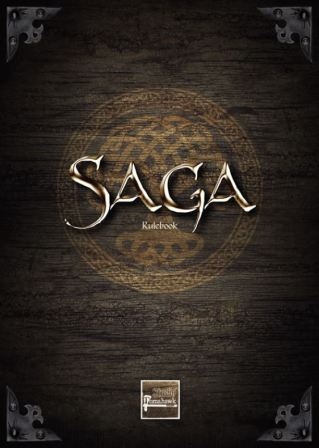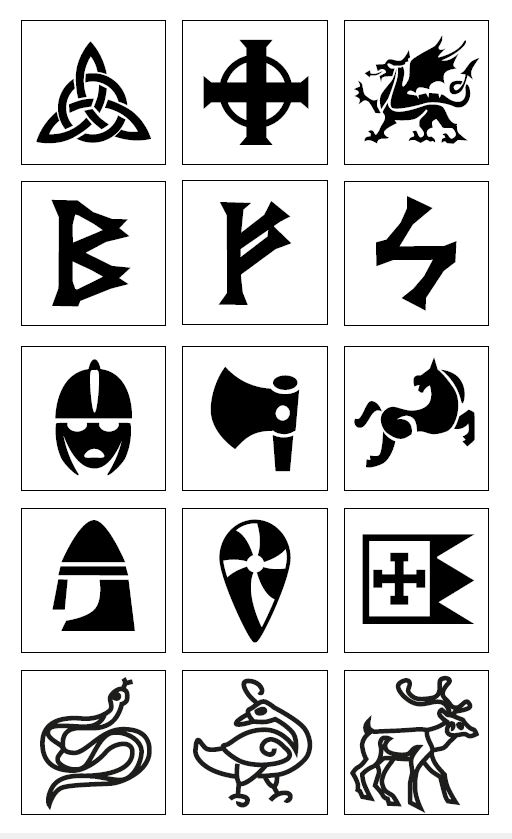|
|
||||||||||
 |
|
The Rules Directory only works if you help. Write a review. Get the review template here. |
|
TITLE: Saga 2nd Edition AUTHOR: Alex Buchel PUBLISHER: Studio Tomahawk PUBLICATION DATE: 2018 WEB SITE/SUPPORT FORUM: Player support can be obtained on the Studio Tomahawk forums. PRICE (with date): $15.00 (in 2018) REVIEWED BY: Mark “Extra Crispy” Severin PERIOD COVERED: The Dark Ages THE BOOK: Saga 2nd Edition is a slim paperback of 50 pages, full color throughout. This book includes only the “base” rules for the game. In order to play, you will also need a supplement which they refer to as “Universes.” The supplements include the battle boards (more below) and army lists, plus any special rules for specific periods or armies. The layout is well done and quite pleasing to the eye. Colors are well chosen and are utilized to feature major rules sections, handy summaries and designer’s notes. There are copious diagrams and illustrations, all in full color. SCOPE: Saga is a pre-gunpowder skirmish game adaptable to many periods. ARMY SIZE: Armies are small, being comprised of units of 4, 8 or 12 figures. Armies will typically be in the 40-60 figures range. BASE UNIT: Figures in Saga are organized in to small units, which move and fight together. GAME SCALES:
BASING SIZES: Figures should be based individually. No specific shape is required but sizing guidelines are given as minimum and maximum sizes (these will allow for all of the most common bases used by figure makers). TURN SEQUENCE:
GAME MECHANICS: Battle Boards and Saga Dice: The core of this game is the use of Battle Boards and Saga dice. First, the dice. Saga dice are custom six sided dice, with each side marked with a rune or symbol. Every Saga dice has one symbol on three sides, another symbol on two sides, and finally a third symbol on the sixth side. Effectively, all Saga dice are D6s but marked 1,1,1,2,2,3. So while the dice are fun and add color to the game, normal dice can be used. A set of Saga dice includes 8 dice - a player may never use more than 8 Saga dice in a game. Here is a picture of the icons (you can print these out and make your own dice if you like):
(Note: melee and shooting are resolved using normal six sided dice.) The second major component is the Battle Board. In Saga, each faction has a unique Battle Board. The Board is broken in to two sections: boxes above the faction name and boxes below it. Each box contains an order or ability, and icons for the dice needed to activate it. Boxes above the name may be used multiple times per turn. Those below only once per turn. For example, to activate a unit of Bondi may require a dice with either the “Y” shaped rune, or the “S” shaped rune. These correspond to the 1 and 6. To use Saga dice you roll them, spending dice to activate units or abilities. However, you must spend a die with the required rune. So poor troops which only activate on “B” rune or “S” rune, are hard to move. Those runes are only on 3 of the 6 sides. Hearthgard may be activated by any rune. Thus the resource allocation of dice to abilities is a key component of the game. You need to have a plan so that you can decide how you will allocate your Saga dice during the turn. It is possible to play dice on your board in one turn but use that ability in a later turn. A few more powerful abilities require spending two dice. Provided you have the dice for it, units may be activated multiple times per turn. For example, you might move your Hero three times in one turn! BUT for every activation after the first, the unit acquires a fatigue marker. Movement: Movement in Saga is quite unusual for a skirmish game of this type. The movement rate of units is given as VS (Very SHort, or 2”); S (Short, or 4”), M (Medium or 6”) or L (Long, or 12”). Movement is regulated by sticks of the appropriate length (Saga also sell laser cut sticks of the correct size). When a player spends dice to activate a unit to move it, he moves figures one at a time. To do so he places a stick and then moves the figure along it in a straight line. You may move less than your full distance. Units with a movement rate of L (12”) may instead use two M sticks. In this case they may carry out a turn. They move in a straight line all the way to the end of the first stick (6”). They may now lay down the second stick in a different direction, effectively executing a turn. But you must move all the way down the first stick. It is also possible to spend dice to add movement to a unit. In this case it may execute a turn similar to a unit moving L. They place the first stick, move all the way to the end, then place the second, which may align in a different direction. In addition, units must always be in cohesion. Each figure in a unit must be within VS (2”) of another figure in the unit. A player may never act so as to break cohesion. Interpenetration is prohibited. No figure may be moved or placed in between two figures of another unit, friendly or enemy. Terrain is either Uneven, Dangerous or Impassable. Uneven terrain slows all units to S (4”). Dangerous both slows the unit and causes it to pick up a Fatigue marker (see below). Charging: A Charge is just like a Move but with two notable differences. First, a unit’s charge distance may differ from it’s move. It may move faster than it charges, or vice versa. Second, a charge must always be in a straight line. So even a unit with a Charge of L (12”) must move in a straight line - it may not use two M sticks to turn. At the conclusion of a charge a melee is fought. Shooting: In order for a unit to shoot ranged weapons, the player needs to activate it by spending the appropriate Saga dice. He then nominates a target in range and line of sight. Attack dice are rolled to score hits, and defense dice are rolled to negate them. Each figure of a given troop type is rated for shooting dice (called Aggression). Typical warriors get 1 dice per figure. Heroes more, levy less (as few as 1/3 dice per figure, rounding up). The number of dice may then be modified by abilities, activated by spending more Saga dice. Line of sight and range are calculated individually, so some of your figures may be out of range, or have a blocked LOS while others are able to shoot. Attack dice are now rolled, and every die scoring equal to or higher than the target’s armor scores a hit. The defender now rolls one die for every hit. A score of 4+ negates the hit. Again, each side may spend more Saga dice to influence these dice rolls. In addition, the shooter’s fatigue may be used to influence the dice (see below). The defender now removes a figure for every hit. Melee: Melee is resolved similar to shooting. Each side calculates how many dice they attack with. Again, the number of dice is decided by troop type, and may be influenced by activating abilities by spending more saga dice. As with shooting, your opponent’s Fatigue may be used to help you in melee. Prior to the melee the defender may Close Ranks. Not all units may do so, but those that do are considered to be in cover which assist their defense dice. However, the number of attack dice they throw is halved. Each side now rolls their dice, scoring hits for every die that equals or exceeds the enemy’s armor rating. For each hit scored against them, a defense die is rolled. On a 5+ the hit is negated. Again, these results may be modified by spending more Saga dice to activate certain abilities. The loser is the side that took more losses. Figures are removed for each hit, and the loser Withdraws S (4”). The withdraw is performed like a normal move using the S move stick. Each unit involved now receives a Fatigue marker. Fatigue: Throughout the game, units may acquire fatigue. They do so by moving through dangerous terrain, engaging in melee, activating more than once etc. Units may have up to 3 markers, excess being ignored. A unit with 3 markers is Exhausted and in its next activation must Rest. A Rest activation removes one marker. A unit may not rest if it has already activated this turn (so, you can only rest once - but you could rest, remove a marker and then activate again by moving, thus earning the fatigue marker right back!). Fatigue may be used by the enemy to cancel your activations. If your unit has 2 fatigue and you activate it, the enemy may use the fatigue. The activation is canceled, the Saga dice are wasted, and the fatigue markers are removed. During shooting Fatigue may be used to raise your unit’s armor rating by one. In melee Fatigue gives you an option. You may either raise your own armor by one, or lower your enemy’s by one. ARMY LISTS/SCENARIOS: No Battle Boards or army lists are included with this core rule book. You will need to buy at least one supplement to play the game. The first supplement “Age of Vikings” was released at the same time and naturally future “universes” will be released soon. There are plans for a Fantasy universe as well as supplements for various historical periods. REVIEWER’S COMMENTS: The book is very attractive, and makes good use of diagrams and illustrations. The rules are fun and easy to read. While the mechanics seem quite easy, it is clear that the nuance comes in understanding your army and how bets to utilize its special abilities to best effect. The allocation of Saga dice is as much a core part of the game as movement or shooting! PLAYER’S COMMENTS: Not played. |
|
[Home] [15mm World] [Reviews Home] [How To] [Beginners Guide] [Gamer's World] [Spanner & The Yank] [Points of View] [The Annex] [Links] [Say Howdy] [Corporate Schill] [Rules Directory] |
 |

